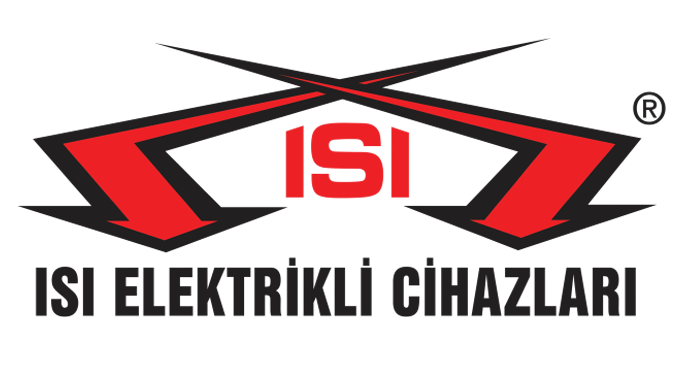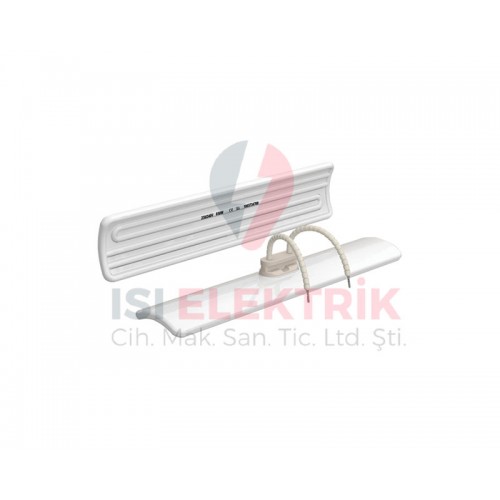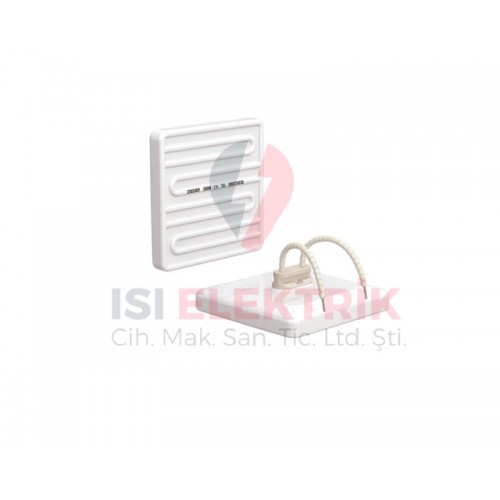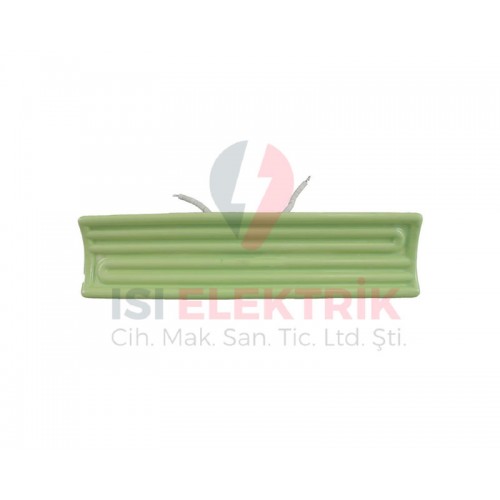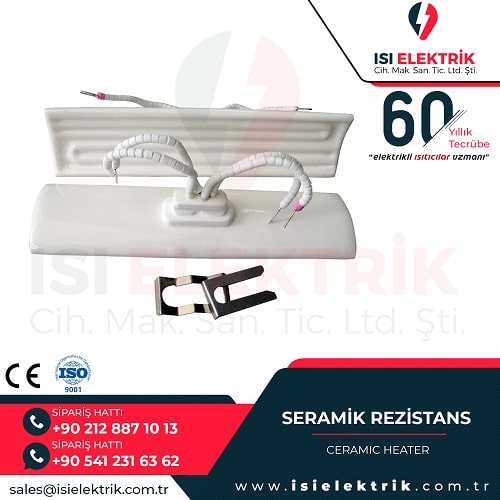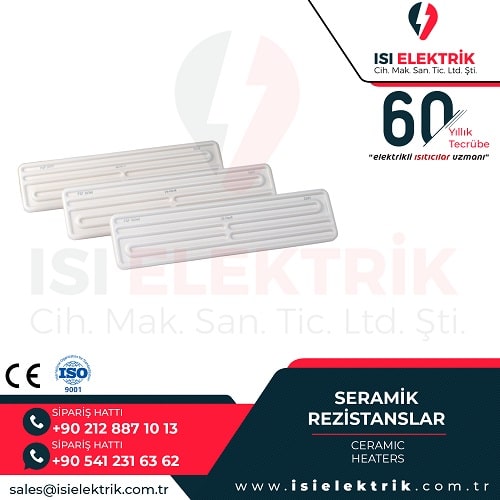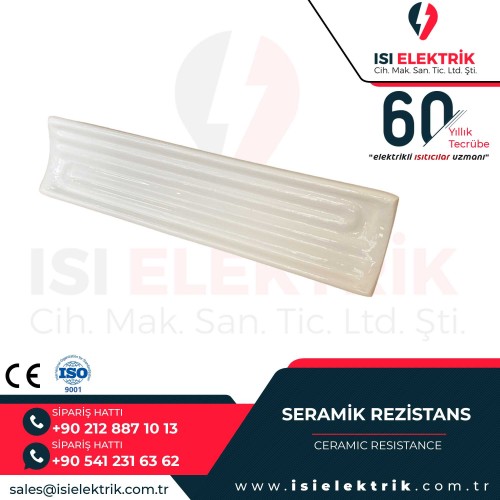Ceramic Heaters
Ceramic heaters are heating elements that have the ability to convert electrical energy into heat within a very short period. Due to their high efficiency, they are widely preferred in both industrial and household applications. These heaters provide a heat performance close to solar temperature, ensuring rapid and effective warming.
One of the most remarkable features of ceramic heaters is their long-lasting and durable structure. Even when exposed to high temperatures, they maintain stable performance, offering an efficient heating experience. The special ceramic materials used in their production enhance thermal resistance, minimizing the risks of wear, cracking, and deformation.
These heaters ensure high heat transfer efficiency due to their wide surface design. A larger surface area allows for a more even distribution of heat, improving energy efficiency and creating a more balanced heating process. Additionally, their rapid heating capability helps save energy, while their controlled cooling process provides long-term usage benefits.
Ceramic heaters are widely used across various industries. They are commonly preferred in industrial machinery, plastic processing, medical devices, laboratory equipment, and food processing systems due to their high-temperature resistance and efficiency, offering cost advantages for businesses. Moreover, they are also used safely in household appliances such as ovens, hair styling tools, and water heaters.
In conclusion, ceramic heaters stand out as heating elements known for their durability and high heating efficiency. With their wide range of applications, long-lasting structure, and energy-saving technology, they provide an ideal solution for various needs.
Ceramic heaters are extremely useful for providing heat to large surfaces. It provides a mass heat release on the machine parts that need to be heated in this manner. Because it emits high temperatures, the ceramic body acts as a ray absorber. As a result, it offers a healthy heating experience in a heated environment. Ceramic heaters are among the most accurate options if the heating experience is required at very high temperatures.
Ceramic Heaters Usage Areas
Ceramic heaters are used in a variety of industrial and engineering applications. These items are also suitable for use on flat solid fuel heater bodies. These heater models are high-quality, long-lasting products. Furthermore, it is a critical component for infrared heaters. These are heaters that transmit long-wave infrared radiation.
These heaters are also used for their high performance in thermoform heating systems, packaging companies, open-air heaters, and infrared heating elements. At the same time, it is one of the most effective types of heater in places with high heat, such as way stations and saunas.
Ceramic heaters are also used in cube sugar machines, fabric, printing, and paint drying facilities in industrial settings. It's also found in vacuum packaging machines. All at the same, ceramic heaters can be seen on the auto paint drying system, industrial oven, and IR drying panels.
Ceramic Heater Technical Specifications
• Ceramic heater types are produced in the dimensions you want, as 220
and 230 V. Supply voltages can also be increased, generally up to 400 V.
• We also have production options with metal, glass, or
ceramic covers.
• We also take your orders for 380 V thermocouples for high-performance
needs in ceramic heaters.
• We take orders according to your needs in different
powers between 125 W and 1000 W for ceramic heaters with an operating voltage
of 220 V.
• Ceramic heater types are available in standard sizes
of 245*60 mm and 122*60 mm. If you require it, we can also produce it in custom
sizes such as 245*100 mm, 100*100m, 122*122 mm, and 60*60mm.
• Ceramic heater models can operate at temperatures of
up to 1100 degrees.
• In these heaters, static belt stones are arranged on
chrome and nickel wire. The outer surfaces of the products are then covered
with stainless sheets.
• Thermal permeability is high in ceramic heaters. As a
result, it can last for a long time while also allowing heat to be transferred
quickly.
• It provides energy savings between 25% and 50% in
products wrapped with ceramic fiber.
• Because these heaters operate at high temperatures and
have high power, connections are made with heat and
amperage-resistant static terminals and plugs.
• We also make multi-core nickel glass fiber and steel
armor cable, which can withstand 400 degrees, for your orders.
• In ceramic heaters, you can load up to 8.5 Watts per square centimeter.
Ceramic Heater Prices
Ceramic heaters are produced in various sizes and power capacities to meet your specific needs. These heaters are widely used in both small-scale devices and large industrial machinery, offering high efficiency and durability. Using the highest quality materials in production ensures long-lasting and energy-efficient products. The prices of ceramic heaters vary depending on the selected model, power capacity, and technical specifications.
Ceramic heaters are preferred in many industrial sectors due to their high-temperature resistance and rapid heating capabilities. With precise engineering principles applied during production, we provide the most suitable solution for each customer. To get detailed information about ceramic heater prices, you can contact us. Our technical team will determine the best product for your application and offer you a customized price quote.
The pricing of ceramic heaters depends on factors such as raw materials, production techniques, heating capacity, and custom design requirements. In addition to standard sizes, we can manufacture products tailored to special projects. To ensure the most accurate pricing, sharing detailed technical specifications of your needs will help us provide the best possible quote.
Our products are manufactured according to the highest quality standards and are customized based on your order. We design ceramic heaters to match your specific technical requirements and deliver them within your requested timeframe. With our personalized production approach, we provide solutions that precisely meet the needs of your business or personal applications.
Our ceramic heaters stand out as one of the most reliable heating solutions in the industry due to their energy efficiency, long lifespan, and high heat transfer capacity. If you are looking for the best prices on high-quality and reliable ceramic heating solutions, feel free to contact us for more information. We are committed to providing competitive pricing and tailored solutions to meet your specific needs.
Types of Ceramic Heaters
- Block Ceramic Resistors: These are rectangular or square blocks, typically used in industrial furnaces, stoves, and heating systems.
- Porcelain Chamber Resistors: Heating elements located inside porcelain chambers. They are resistant to high temperatures and commonly used in industrial furnaces and thermal processing applications.
- Coil Ceramic Heaters Heating elements wound in a coil shape and usually placed inside a round or cylindrical casing. These resistors are preferred in air and liquid heating systems.
- Ceramic Band Resistors: Long and narrow ceramic strips typically used in industrial processes. They are resistant to high temperatures and provide homogeneous heat distribution.
Technical Specifications of Ceramic Heaters
- Capacity: Ceramic heaters are manufactured in a wide range of power capacities to suit various applications. With capacities ranging from 200 Watts to 4000 Watts, they can be used in small devices as well as large industrial systems. Custom production options are also available for higher power requirements.
- Voltage: Designed to operate at different voltage levels ranging from 24 Volts to 480 Volts. This wide voltage range allows for easy integration into various industrial and commercial applications. Custom voltage configurations can be provided based on specific project needs.
- Temperature Range: Capable of operating within a temperature range of 0°C to 600°C. Due to their high heat resistance, ceramic heaters provide efficient and stable heating performance even in continuous operations. Their resistance to thermal shock ensures long-term durability.
- Body Material: Depending on the application and environmental conditions, the body of ceramic heaters can be made from stainless steel, aluminum, or brass. Stainless steel bodies offer high heat resistance and corrosion protection, while aluminum provides a lightweight alternative. Brass is preferred for applications requiring high thermal conductivity.
- Heating Element Material: Manufactured using high-temperature-resistant materials such as nickel-chromium, stainless steel, and Inconel. Nickel-chromium is known for its rapid heating and high resistance properties, while stainless steel and Inconel provide durability in harsh environments.
- Insulation Material: Ceramic insulation minimizes heat loss and ensures safe operation at high temperatures. Its excellent electrical insulation properties enhance energy efficiency and provide long-lasting performance.
- Size: Ceramic heaters can be custom-designed according to the dimensions and shape of the area to be heated. In addition to standard sizes, tailored solutions can be developed for specific systems, ensuring compatibility with various industrial and commercial applications.
- Connection Type: Available in different connection options, including clamp, cable, plug, and screw connections. This variety of mounting options makes it easier to integrate them into different systems. The most suitable connection type can be chosen based on the application requirements, ensuring a quicker and more efficient installation process.
Our ceramic heaters are designed to meet industrial heating needs with high efficiency, long lifespan, and a wide range of applications. For custom solutions and detailed technical information, please feel free to contact us.
Advantages of Ceramic Heaters
- Uniform Heat Distribution: Ceramic resistors distribute heat evenly across a wide area.
- Longevity: Ceramic resistors have a durable structure that can withstand high temperatures for extended periods.
- Durability: Ceramic resistors are resistant to mechanical impacts and abrasion.
- Efficiency: Ceramic resistors utilize energy efficiently, resulting in electricity savings.
- Safety: Ceramic resistors have insulated structures, minimizing the risk of electric shocks.
- Easy Maintenance: Ceramic resistors are easy to maintain devices.
- Versatility: Ceramic resistors come in various power ratings, voltages, temperature ranges, and sizes.
- Wide Range of Applications: Ceramic resistors can be used in many different fields.
- Economical: Ceramic resistors are more cost-effective compared to other heating elements.
Materials Used in the Production of Ceramic Heaters
- Insulation Coatings: Some models of ceramic heaters are coated with special insulation layers to ensure safer operation at high temperatures and to provide additional protection against external factors. These coatings enhance the heater’s efficiency while increasing its resistance to environmental conditions. Ceramic-based coatings, silicone-based insulations, or special oxide coatings can be used to provide protection against corrosion, moisture, and chemical exposure.
- Thermal Pastes and Insulation Connection Materials: Thermal pastes and insulation connection materials are applied at the connection points and insulation areas of ceramic heaters to optimize heat transfer and improve electrical insulation. These pastes help the heating elements make better contact with surfaces, improving heat distribution and efficiency. Additionally, thermal pastes are highly resistant to extreme temperatures, ensuring a longer operational lifespan.
- Connection Components and Terminals: Proper selection of connection components is essential for the safe and efficient operation of ceramic heaters. Various connection elements such as terminals, clamps, screws, and soldered connections are used in electrical installations. These components are made from materials such as copper and stainless steel, providing high conductivity and corrosion resistance for long-term durability.
- Protective Coatings: In some applications, ceramic heaters require protection against environmental conditions. Special protective coatings are used in humid, chemically exposed, or abrasive environments to prevent oxidation of the heating elements, enhance mechanical resistance, and minimize performance degradation. Common protective materials include ceramic-based insulation layers, silicone coatings, and high-temperature-resistant metal oxide compounds.
- High-Temperature-Resistant Ceramic Components: One of the key structural elements of ceramic heaters is their high-temperature-resistant ceramic components. These materials provide excellent insulation properties and durability, ensuring the heater’s longevity. High-performance ceramic types used in heater production include alumina (Al₂O₃), silicon carbide (SiC), and zirconia (ZrO₂), each offering superior heat resistance and mechanical strength.
- Stainless Steel, Aluminum, and Nickel-Chromium Support Structures: To enhance the mechanical strength of ceramic heaters, support structures made of stainless steel, aluminum, and nickel-chromium are used. These materials maintain their structural integrity even at high temperatures, ensuring reliable and long-lasting operation. Additionally, these support structures are often incorporated into the heater’s mounting frame and housing systems, making installation easier and more secure.
The materials used in the production of ceramic heaters directly impact their performance, safety, and durability. Selecting the appropriate materials for a specific application is crucial for achieving the best results. For customized solutions and detailed technical information, please feel free to contact us.
Technical Details to Consider When Choosing Ceramic Heaters
- Power: The power rating of ceramic resistors depends on the size of the area to be heated and the desired temperature.
- Voltage: The voltage of ceramic resistors should be compatible with the electrical power source to be used.
- Temperature Range: The temperature range of ceramic resistors should be suitable for the desired temperature range of the area to be heated.
- Body Material: The body material of ceramic resistors should be suitable for the environment in which they will be used.
- Heating Element Material: The heating element material of ceramic resistors should be selected according to the desired temperature and service life.
- Size: The size of ceramic resistors should be appropriate for the size of the area to be heated.
- Connection Type: The connection type of ceramic resistors should be suitable for the electrical system to be used.
Features of Ceramic Heaters That Ensure High Thermal Efficiency
- Fast Heating and High Heat Transfer: Ceramic heaters rapidly convert electrical energy into heat. Thanks to the high thermal conductivity of ceramic materials, energy loss is minimized, and heat is efficiently transferred directly to the target surface, allowing them to reach maximum temperature in a short time.
- Even Heat Distribution: Ceramic heaters ensure uniform heat distribution across the surface area. This feature is especially beneficial in industrial processes and sectors such as plastic, rubber, and metal forming, where balanced and efficient heating is essential.
- Energy Efficiency: With minimal heat loss and maximum energy utilization, ceramic heaters offer higher efficiency compared to other heating elements. Their high heat capacity helps optimize energy consumption, reducing operating costs.
- High Heat Resistance: Designed to withstand temperatures of 600°C and above, ceramic heaters maintain stable performance at high temperatures and minimize the risk of overheating-related issues.
- Long Lifespan and Durability: The robust structure of ceramic materials provides high resistance to mechanical wear and chemical exposure. Their oxidation-resistant properties extend their operational lifespan and reduce maintenance requirements.
- Low Thermal Expansion: The low thermal expansion coefficient of ceramic materials ensures that they remain stable even under rapid temperature fluctuations. This feature enhances their reliability in applications where sudden temperature changes occur frequently.
- Various Surface and Design Options: Ceramic heaters can be manufactured in different shapes and sizes to suit various applications. They are available in flat plates, round tubes, or custom-designed formats, making them adaptable to different industries.
- Eco-Friendly Heating Solution: Ceramic heaters provide direct heating, minimizing energy loss and contributing to a lower carbon footprint. Their efficient energy usage makes them an environmentally friendly heating solution.
With their high-temperature resistance, energy efficiency, and long-lasting design, ceramic heaters are among the most preferred heating solutions in industrial and commercial applications. For more information on the best ceramic heater options for your specific needs, feel free to contact us.
Energy Savings with Ceramic Heaters
- High Thermal Efficiency: Ceramic heaters operate with maximum efficiency by rapidly converting electrical energy into heat. Since they transfer heat directly to the target surface, energy loss is minimized, allowing for high temperatures with lower energy consumption.
- Low Heat Loss: Ceramic materials have excellent thermal insulation properties. This reduces the amount of heat lost to the surrounding environment, ensuring that most of the generated heat is directly transferred to the material being processed. This feature significantly reduces unnecessary energy usage.
- Fast Heating and Cooling: Ceramic heaters have the ability to heat up and cool down quickly. Unlike traditional heaters, they reach their operating temperature in a very short time and cool rapidly when not needed, preventing excessive energy consumption.
- Programmable Temperature Control: Ceramic heaters can be integrated with advanced thermostats and temperature control systems. This allows for optimized heating based on demand, preventing unnecessary energy consumption.
- Long Lifespan: Due to their high heat resistance, ceramic heaters are highly durable and require minimal maintenance. Less frequent maintenance and component replacement help lower operating costs and contribute to long-term energy savings.
- Insulated Design: The insulated structure of ceramic heaters prevents energy loss caused by external factors. This design not only ensures more efficient heat utilization but also minimizes overall energy consumption in the working environment.
- Prevention of Unnecessary Operation: Ceramic heaters can be equipped with automatic control systems that turn them on and off as needed. This ensures they operate only when necessary, preventing wasteful energy consumption.
- Eco-Friendly Solutions: Energy-efficient ceramic heaters contribute to reducing the carbon footprint. Their lower energy consumption provides an environmentally friendly heating solution and supports sustainable production processes.
Ceramic heaters maximize energy savings by providing efficient heating. To reduce operational costs and create a more eco-friendly production process, you can choose ceramic heating solutions. Contact us for the best options tailored to your needs.
Technical Details to Consider When Choosing a Ceramic Heater
- Power and Voltage Ratings: The ceramic heater should be selected based on the power (Watt) and voltage (Volt) requirements of the system in which it will be used. Incorrect power and voltage selection can negatively impact heating performance and lead to energy losses.
- Operating Temperature: The ceramic heater should be chosen according to the maximum temperature required for the application. Typically, ceramic heaters operate within a temperature range of 0°C to 600°C, which should align with the needs of the application.
- Size and Shape: The heater should be selected to fit the surface area it will be applied to. The dimensions and shape of the heated area should be considered to determine the most suitable model.
- Material Quality: The body and heating element material of the ceramic heater should be resistant to high temperatures. Durable materials such as stainless steel, aluminum, or brass should be preferred to ensure long-lasting performance.
- Heat Distribution: The ceramic heater should provide uniform heat distribution across its surface. Even heat distribution ensures efficient heating and prevents energy loss.
- Mounting and Connection Types: The mounting and connection method of the ceramic heater should be suitable for the application. Different connection options, such as clamp, cable connection, or plug-in models, should be evaluated.
- Temperature Control: The ceramic heater should be compatible with thermostat or PID control systems for precise temperature regulation. Accurate temperature control ensures a safer and more efficient operation.
- Durability and Longevity: High-quality ceramic heaters can operate stably at high temperatures for extended periods. Models resistant to chemical and mechanical wear should be selected.
- Energy Efficiency: Ceramic heaters that provide high-efficiency heating with low energy consumption should be preferred. This reduces operating costs and offers an environmentally friendly heating solution.
- Application Suitability: The ceramic heater should be chosen based on the industry and specific application requirements. Custom designs should be considered for industrial furnaces, plastic processing machines, packaging industries, or laboratory applications.
Selecting the right ceramic heater is crucial for efficient system operation and long-term durability. Paying attention to technical details and consulting with experts will help you find the most suitable model for your needs. Contact us for more information on the best ceramic heater options for your application.
Ceramic Heater Working Principle
- Conversion of Electrical Energy into Heat: Ceramic heaters operate by converting electrical energy directly into heat. The internal resistance wires heat up when electric current flows through them, transferring the heat to the ceramic surface and radiating it into the environment.
- Heat Conductivity of Ceramic Material: Ceramic is an excellent heat conductor and insulator. This property allows ceramic heaters to reach high temperatures while minimizing heat loss, ensuring efficient heating.
- Infrared Radiation: Some ceramic heaters work using infrared radiation, directly transferring heat to the target surface. This enables non-contact, fast, and even heating.
- Uniform Heat Distribution: The surface of ceramic heaters is designed to distribute heat evenly. This prevents overheating or cold spots in certain areas, ensuring balanced heating.
- Fast Heating and Cooling: Ceramic heaters quickly reach their target temperature when powered on. When turned off, they cool down rapidly, contributing to energy savings.
- Temperature Control and Safety: Ceramic heaters can be integrated with thermostats and temperature control systems. This prevents overheating and ensures operation within the desired temperature range.
- Durability and Longevity: Made from high-temperature-resistant materials, ceramic heaters are resistant to chemical and physical wear, providing long-lasting performance.
- Energy Efficiency: With direct heat transfer and minimal heat loss, ceramic heaters offer high energy efficiency. This helps reduce operational costs while providing a sustainable heating solution.
Ceramic heaters are widely used in industrial and domestic applications due to their fast and efficient heating capabilities. For more information and details on the most suitable ceramic heater models, feel free to contact us.
Frequently Asked Questions
Ceramic Infrared Heaters
